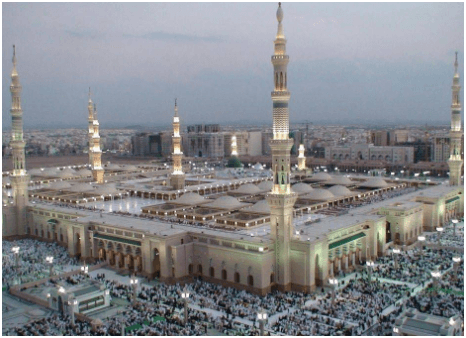Makkah’s Grand Mosque Amid Haj Conclusion : Extreme 51.8°C Heat Grips
Temperatures soared to a scorching 51.8°C (125.2°F) at the Grand Mosque in Makkah as the annual Hajj pilgrimage came to a close, marking one of the highest recorded temperatures in the area. This intense heatwave added to the already strenuous conditions faced by the millions of Muslims undertaking the pilgrimage, which is one of the five pillars of Islam and a once-in-a-lifetime duty for all Muslims who are physically and financially able to perform it.
The Hajj, which attracts around two million pilgrims each year, involves several days of rigorous physical activities including long walks and standing for extended periods. This year, the extreme temperatures posed significant challenges for the pilgrims, many of whom come from cooler climates and were not accustomed to such severe heat. The Saudi authorities had anticipated the extreme weather and implemented several measures to ensure the safety and well-being of the pilgrims.
Cooling stations in Makkah were set up throughout the pilgrimage sites, providing shaded areas, fans, and misting machines to help reduce the risk of heat-related illnesses such as heatstroke and dehydration. Additionally, the Ministry of Health deployed thousands of healthcare professionals and volunteers to assist with medical emergencies and offer support to those in need. The use of modern technology, such as smart bracelets that monitored pilgrims’ health conditions and provided real-time data to health services, was also expanded to improve the efficiency of medical responses.
Despite these efforts in Makkah , the extreme heat led to numerous cases of heat exhaustion and other related health issues. Many pilgrims were seen carrying umbrellas, water bottles, and portable fans to cope with the high temperatures. The Saudi Red Crescent Authority reported a significant increase in the number of emergency calls during the peak heat hours, with many cases requiring immediate medical attention.
The high temperatures in Makkah also affected the overall atmosphere of the Hajj. Traditionally, the pilgrimage is a time of intense spiritual reflection and communal prayer, but this year’s extreme weather made it difficult for many to focus solely on their religious duties. Pilgrims had to balance their spiritual commitments with the practical need to stay hydrated and avoid heat exposure. This led to a more subdued and cautious approach to the rituals, with many taking frequent breaks to rest in shaded areas.
The Saudi government has been making continuous improvements to the infrastructure and facilities at the Hajj sites to enhance the experience for pilgrims. This includes the expansion of the Makkah Grand Mosque, which now accommodates up to two million worshippers, and the construction of new transportation systems to ease the movement of people between the holy sites. However, in Makkah the unprecedented heatwave highlighted the ongoing challenges posed by climate change and the need for further adaptations to ensure the safety and comfort of pilgrims in the future.
In response to the rising temperatures in Makkah , the Saudi authorities have also been promoting awareness campaigns about the importance of staying hydrated and recognizing the signs of heat-related illnesses. Pilgrims were advised to drink plenty of water, avoid direct sunlight during peak hours, and seek medical help if they felt unwell. These messages were disseminated through various channels, including social media, mobile apps, and on-site announcements in multiple languages to reach the diverse population of pilgrims.
The extreme weather conditions during this year’s Hajj have sparked discussions about the potential impact of climate change on future pilgrimages. Experts warn that rising global temperatures could lead to more frequent and severe heatwaves in the region, posing greater risks to the health and safety of pilgrims. This has prompted calls for more sustainable and climate-resilient planning for the Hajj, including the development of green infrastructure and the use of renewable energy sources to power cooling systems and other facilities.
Stay up to date with every latest news-click here



